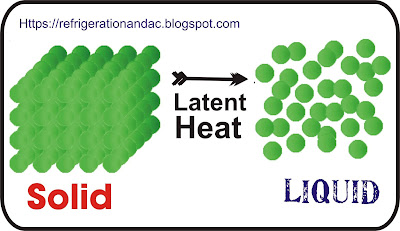A physical phenomenon of all pure substances is their ability to change their state, such as solid to liquid and liquid to gas. These changes of state occur at the same temperature and pressure combinations nations for any given substance. It takes the addition of heat or the removal of heat to produce these phenomena. We call heat which brings about a CHANGE OF STATE, WITH NO CHANGE IN TEMPERATURE, LATENT (hidden) HEAT.
It may be noted in Fig. 1-16 that although considerable heat (144 Btu) was added between points A and B, the temperature did not change. This heat was required to change the ice to water. This heat is called latent heat of fusion during a cooling operation or latent heat of melting during a heating operation. Likewise, between points C and D, 970 Btu were added and the temperature did not change. This heat was required to change the water to steam. This heat is called the latent heat of vaporization.
There are two latent heat for each substance, solid-to-liquid heat (melting and freezing) and liquid-to-gaseous (vaporizing and condensing). If heat is being added to a substance, the heat required to change the substance from the solid state to the liquid is called the latent heat of melting or fusion.
The heat required to change the liquid to vapor is called the latent heat of vaporization.
If heat is being removed from the substance (cooled-meaning that energy is subtracted), the heat removed to condense the vapor to a liquid is still the heat of vaporization but in this case, it is called the latent heat of condensation. As the liquid is cooled to change the substance from a liquid to a solid state, this heat is again called the heat of fusion or freezing. Fig. 1-17 shows the latent heat for water and several common refrigerants.
Latent Heat of
Freezing Vaporization or
or Melting Condensation
Material Btu/1b Btu /lb.
Water 144 970.4 at 212 F.
R-717 (Ammonia). . . 565.0 at 5 F.
R-502 68.96 at 5 F.
R-40 (Methyl chloride) 178.5 at 5 F.
R-12 68.2 at 5 F.
R-22 93.2 at 5 F.
Fig. 1-17. A table of the latent heat of vaporization
value of water and some common refrigerants. The
latent heat of fusion is only given for water as the
refrigerants do not freeze at temperatures commonly
handled by the refrigeration service engineer.
The explanation for the change of state is that as the molecules move under a certain pressure their motion will increase to a certain speed but then if further heat is added each molecule undergoes a peculiar change. This change takes place within the molecule. It is believed that there is a shift of atoms within the molecule. It is estimated that one or more of the atoms change their position from the outer face of the molecule to the inside or the reverse. There are other theories, all of them based on molecular motion and magnetic attraction. The heat energy needed to make this change is tremendous. It takes as much heat to change one pound of ice to one pound of water as it does to raise the temperature of that same one pound of water from 32 F. to 176 F. The difference between sensible heat and latent heat should be kept very clearly in mind because all of the basic operations of the compression refrigeration cycle are based upon these two heats, SENSIBLE and LATENT.
Tags:
Basics of Refrigeration

